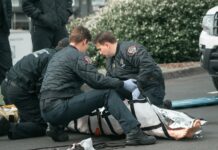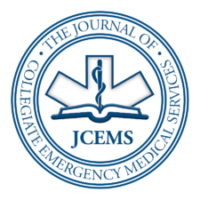Burnout. A label that is all too familiar in healthcare.
Familiar as it may be, burnout does not extinguish a person’s flame all at once. Rather, burnout works slowly, as if dimming a flame that once burned brightly. Each of us starts our work with a passionate flame, fueled by our inner fervor and enthusiasm. Yet, when not properly tended, our flame slowly withers away, leaving behind only a faint trace of what once was. We see burnout in our colleagues, hear about burnout in late-night conversations, and feel burnout slowly closing in on our own careers. Though it surrounds us all, no one expects their flame to wither away—until, all too often, it’s too late.
Many people go into healthcare with a deep desire to help others in life’s most challenging moments. And it’s true: saving lives is incredibly fulfilling. But as we settle into our routines like any other job, whether we’re in the back of an ambulance or inside the sterile walls of a hospital, it’s easy for that once-burning passion to begin to dim. The excitement that used to fuel our marathon shifts can devolve into a sense of routine rather than purpose. The question isn’t whether burnout will come; it’s when. So, when it does, how do we reignite the flame that brought us into this work in the first place?
Take my first partner on the ambulance, Matt, for example. Matt is a seasoned paramedic with 15 years of experience. Through navigating emergencies in downtown Atlanta, he had mastered his skills—but I could sense the job had become routine, and his passion had started to fade. However, when Matt’s old partner retired, and he got paired with me—the new guy—I soon realized that my excitement to learn would spark his desire to teach.
Fresh out of Advanced Emergency Medical Technician (EMT-A) school, I was full of enthusiasm yet lacked any experience with the basics. Skills as simple as obtaining intravenous (IV) access, reading electrocardiograms (ECGs), performing high-quality cardiopulmonary resuscitation (CPR), or administering naloxone seemed like I was moving mountains at first. Yet Matt was there to guide me through these challenges, offering support and insight that helped me grow. And each time I improved, I noticed something in him: a renewed flame.
As Matt passed me the torch of his expertise, my path forward was illuminated. I quickly went from fumbling through emergency calls to taking the initiative in complex situations. After each call we responded to, Matt would give me his feedback on how I could’ve done better or take the time to show me his tips and tricks to refine my technical skills. As a result, with each call we went on, I learned to proceed with more ease and better execution. Over time, we both began pushing each other to continue learning and growing in how we helped patients. Not only did our multi-system trauma calls become highly efficient, but we even began reading medical journals together and exploring new ways to vagal maneuver patients out of cardiac arrhythmias. I began to see us as a ‘well-oiled machine’—or, as I’d now put it, a ‘well-kindled fire’.
After seeing how passing the torch revitalized Matt’s career, I couldn’t help but wonder how I, too, would feel about teaching one day. Though I’m still early in my career, I’ve seen how burnout can creep up on anyone, even in the first few years. Watching Matt rediscover his passion made me realize that teaching and passing on what we know can be a key to keeping that flame alive—for all of us, no matter where we are on our journey. As if keeping a flame in isolation restricts any opportunity it would’ve had to grow. Later, when I had the opportunity to go back to school and study medicine, I didn’t want to wait years to finally have this chance to teach. Instead, I applied to the local technical college and became an EMT instructor, helping to teach night classes to all the aspiring EMTs. During these classes, even while running through the basic steps of IV access on a manikin’s arm, I saw the same passion in my students’ eyes that I had when I was in their shoes not long ago. It reminded me just how powerful teaching can be, not only for the student but for the instructor, too.
After years on the job, it’s easy for the flame to not feel as bright as it was when you first began. When we operate in isolation and don’t make room for other fuel sources to build us up, our passion can burn out. So, what is the fastest way to rekindle your flame? Teach. Pass the torch. Pair up with someone new to the field, and you’ll rediscover the depth of your expertise and how fulfilling it is to build someone up. Skills that have become second nature to you will be eye-opening to beginners. Watching fresh EMTs struggle through the basics will remind you of your own journey– one in which you drew upon different fuel sources to learn and grow along the way. And most importantly, you can remember the spark that drove you to this work in the first place.
My challenge to you is simple: Make the effort to teach. Whether you’re an EMT, nurse, physician, or in any other field, pass on the torch of knowledge you’ve gained. Look for opportunities within your role to train the new person, share your tips with someone who’s struggling, or suggest ways your team can improve its productivity. What do you have to lose? At worst, you’ll remain where you are. But at best, you’ll rekindle the fiery passion that first led you to this career through the excitement and fresh perspective of someone eager to learn. And just maybe, you’ll reignite your own flame to bigger than what it was when you first began.
Author & Article Information
Reagan Williams, BS, AEMT is a third-year medical student at Mercer University School of Medicine. After graduating from the University of Georgia, Reagan went to work for Grady EMS in Atlanta, GA as an Advanced-EMT. After an exciting couple of years, Reagan became eager to continue his studies and returned to school to pursue a degree in medicine. He is a husband and proud father, living with his family in Savannah, GA, while striving to achieve his professional aspirations and contribute to his community along the way.
Author Affiliations: From Mercer University School of Medicine – in Macon, GA (R.B.W.).
Address for Correspondence: Reagan Williams
Conflicts of Interest/Funding Sources: By the JCEMS Submission Declaration Form, all authors are required to disclose all potential conflicts of interest and funding sources. All authors declared that they have no conflicts of interest. All authors declared that they did not receive funding to conduct the research and/or writing associated with this work.
Authorship Criteria: By the JCEMS Submission Declaration Form, all authors are required to attest to meeting the four ICMJE.org authorship criteria: (1) Substantial contributions to the conception or design of the work; or the acquisition, analysis, or interpretation of data for the work; AND (2) Drafting the work or revising it critically for important intellectual content; AND (3) Final approval of the version to be published; AND (4) Agreement to be accountable for all aspects of the work in ensuring that questions related to the accuracy or integrity of any part of the work are appropriately investigated and resolved.
Submission History: Received December 03, 2024; accepted for publication January 07, 2025
Published Online: April 13, 2025
Published in Print: February 21, 2025 (Volume 7: Issue 1)
Reviewer Information: In accordance with JCEMS editorial policy, Perspectives and Opinions manuscripts are reviewed by the JCEMS Editorial Board. JCEMS thanks the Editorial Board members who contributed to the review of this work.
Copyright: © 2025 Williams. This is an open-access article distributed under the terms of the Creative Commons Attribution 4.0 International (CC BY 4.0) License, which permits unrestricted use, distribution, and reproduction in any medium, provided the original author and source are credited. The full license is available at: https://creativecommons.org/licenses/by/4.0/
Electronic Link: https://doi.org/10.30542/JCEMS.2025.07.01.03








